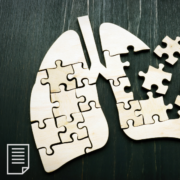Lung Cancer Staging: What Patients Should Know
Lung Cancer Staging: What Patients Should Know from Patient Empowerment Network on Vimeo.
Lung cancer specialist, Dr. Tejas Patil, defines the differences between non-small cell lung cancer (NSCLC) and small cell lung cancer. He goes on to explain how imaging tests such as CT and PET scans are used to stage lung cancer.
Dr. Tejas Patil is an academic thoracic oncologist at the University of Colorado Cancer Center focused on targeted therapies and novel biomarkers in lung cancer. Learn more about Dr. Patil, here.
Download Program Resource Guide
See More From INSIST! Lung Cancer
Related Programs:

Deciding on a Lung Cancer Treatment? Essential Testing for Optimal Care |

|

|
Transcript:
Dr. Patil:
Lung cancer has a bit of a confusing nomenclature. Historically, Lung cancer was divided into small cell lung cancer and non-small cell lung cancer, and this distinction was based on how the lung cancer appeared under a microscope, but it also has practical implications. Small cell lung cancer tends to have a very different biology than non-small cell lung cancer. It originates from neuroendocrine cells and is treated very differently than non-small cell lung cancer.
Non-small cell lung cancer is also a bit of a misleading term because it really is a catch-all term. It represents a wide group of histologies that are not small cell lung cancer. So, basically, anything that isn’t small cell lung cancer will be non-small cell lung cancer, but that group is very heterogenous and includes subtypes like adenocarcinoma, squamous cell carcinoma, adenosquamous, large cell and even sarcoma type variance.
Distinguishing between the two is important because the prognosis and treatment options are actually very different between small cell and non-small cell lung cancer.
After a diagnosis of lung cancer has been made, the most important next step is to establish a cancer stage, and so this is typically done through the TNM staging criteria. The T typically reflects the size of the tumor. The N reflects whether there’s lymph nodes involved with cancer and the M refers to whether there’s a metastasis, and metastasis refers to whether the cancer has spread outside of the lung.
Based on a combination of scores using the TNM criteria, lung cancers are staged from one to four. Now, to establish these different scores, oncologists will typically request varieties of scans. These include CT scans, PET CT scans, MRI and in some cases, very sophisticated ultrasound techniques called endobronchial ultrasound, so that’s the staging component
Staging is a very important component of lung cancer, and at minimum, a patient should have a CT scan of the chest and abdomen with extension down to the adrenal glands. The reason for this is that this type of imaging, at least the extent of the imaging, will cover most of the metastatic sites that lung cancer tends to go towards. Additionally, a PET CT scan can be obtained.
Now, a PET scan is a very unique form of imaging. Patients will receive a radio labeled form of glucose and the principle of a PET scan is that since cancers metabolize glucose, which is sugar at a higher rate than normal tissue, the scan in principle helps clinicians identify spots where cancer could be. One important point about imaging and this is something patients should be aware of, is that lung cancers are unique cancers in that there’s a very high risk of spread to the brain.
And so, as part of baseline staging, almost every patient with lung cancer should be getting an MRI of the brain to rule out brain metastases.
Then a final point I’ll make is that patients with Stage 2 or 3 lung cancer really should have their cases reviewed in a multi-disciplinary context where there’s input from surgeons, pulmonologists, medical oncologists, and radiation specialists because the treatment for Stage 2 and 3 lung cancer can be quite complicated.










